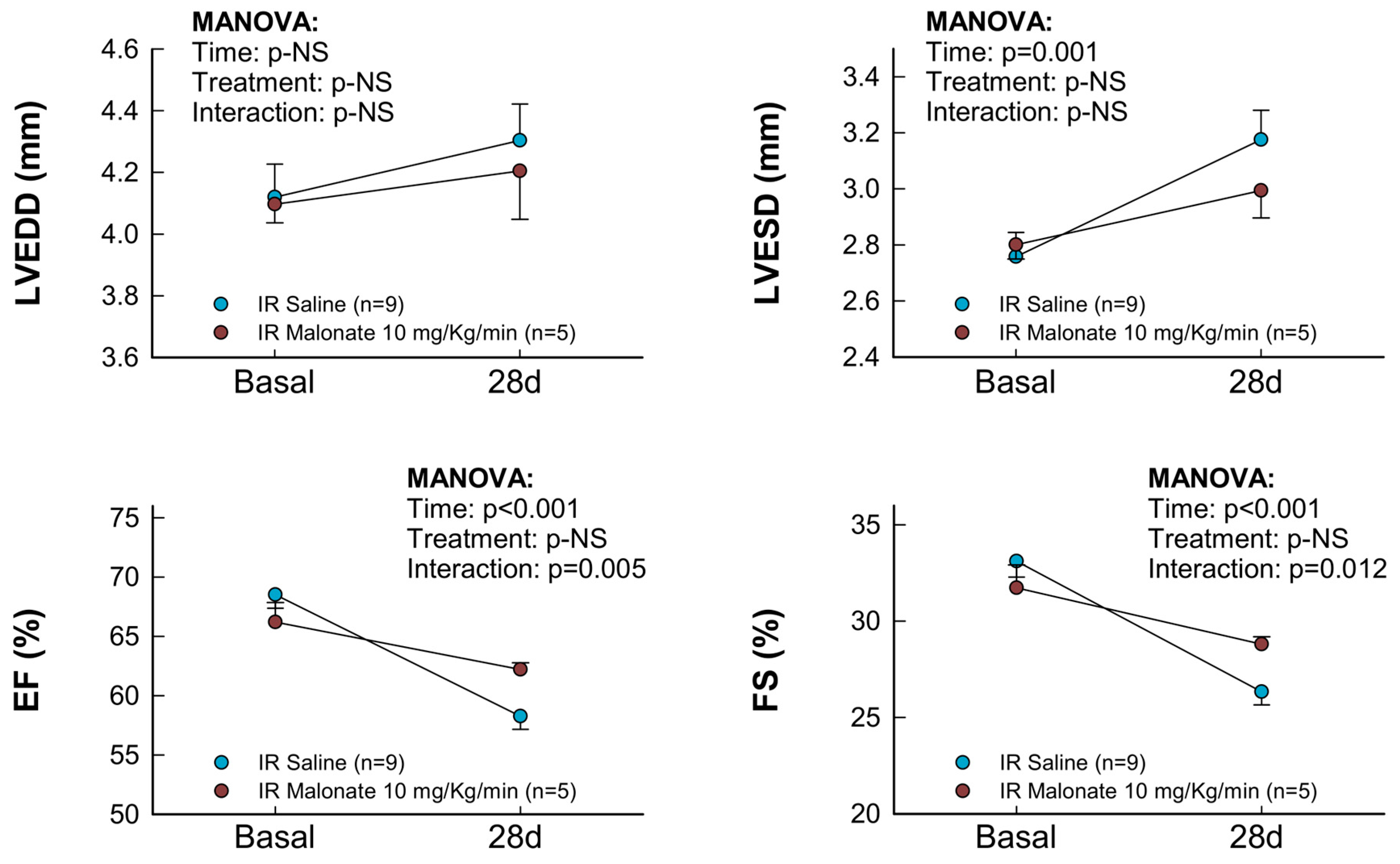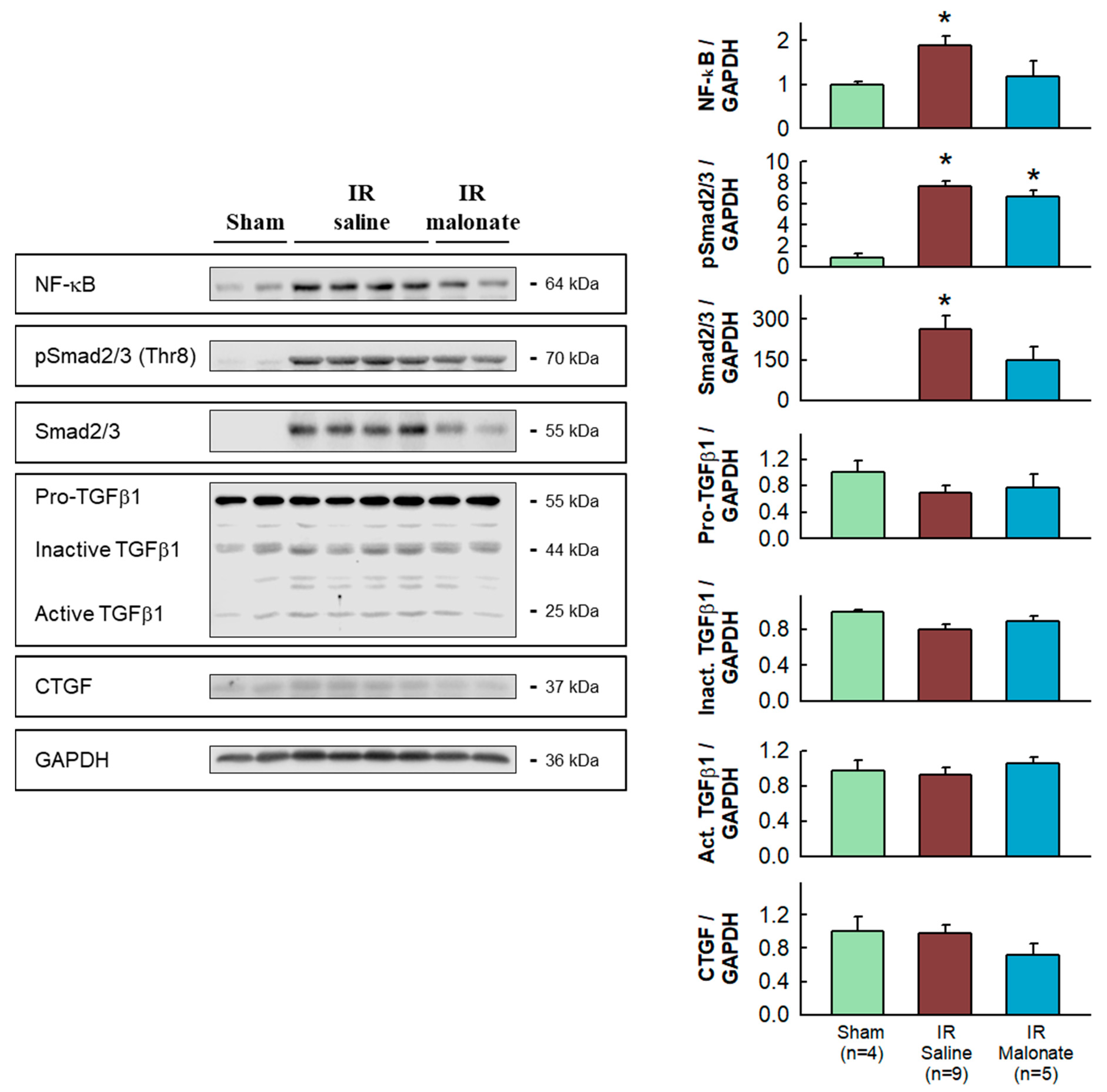Long-Term Protective Effects of Succinate Dehydrogenase Inhibition during Reperfusion with Malonate on Post-Infarction Left Ventricular Scar and Remodeling in Mice
Abstract
:1. Introduction
2. Results
2.1. Short-Term Effects of Reversible Succinate Dehydrogenase Inhibition with Malonate during Reperfusion on Myocardial Infarct Size
2.2. Long-Term Effects of Reversible Succinate Dehydrogenase Inhibition with Malonate during Reperfusion on Scar Size and Post-Infarction Left Ventricular Remodeling
2.3. Expression of Pro-Inflammatory and Fibrotic Markers in the Remote Myocardium
3. Discussion
4. Materials and Methods
4.1. Animals
4.2. Experimental Protocols
4.3. Infarct Size and Myocardial Scar Measurements
4.4. Transthoracic Echocardiography
4.5. Western Blot Analysis
4.6. qPCR Analyses
4.7. Statistics
5. Conclusions
Author Contributions
Funding
Institutional Review Board Statement
Informed Consent Statement
Data Availability Statement
Conflicts of Interest
References
- Chen, Y.R.; Zweier, J.L. Cardiac Mitochondria and Reactive Oxygen Species Generation. Circ. Res. 2014, 114, 524–537. [Google Scholar] [CrossRef]
- Halestrap, A.P.; Richardson, A.P. The Mitochondrial Permeability Transition: A Current Perspective on Its Identity and Role in Ischaemia/Reperfusion Injury. J. Mol. Cell Cardiol. 2015, 78, 129–141. [Google Scholar] [CrossRef] [PubMed]
- Hausenloy, D.J.; Yellon, D.M. Myocardial Ischemia-Reperfusion Injury: A Neglected Therapeutic Target. J. Clin. Investig. 2013, 123, 92–100. [Google Scholar] [CrossRef]
- Granger, D.N.; Kvietys, P.R. Reperfusion Injury and Reactive Oxygen Species: The Evolution of a Concept. Redox Biol. 2015, 6, 524–551. [Google Scholar] [CrossRef]
- Holmstrom, K.M.; Finkel, T. Cellular Mechanisms and Physiological Consequences of Redox-Dependent Signalling. Nat. Rev. Mol. Cell Biol. 2014, 15, 411–421. [Google Scholar] [CrossRef]
- Garciarena, C.D.; Fantinelli, J.C.; Caldiz, C.I.; de Cingolani, G.C.; Ennis, I.L.; Perez, N.G.; Cingolani, H.E.; Mosca, S.M. Myocardial Reperfusion Injury: Reactive Oxygen Species vs. NHE-1 Reactivation. Cell Physiol. Biochem. 2011, 27, 13–22. [Google Scholar] [CrossRef]
- Ekelof, S.; Jensen, S.E.; Rosenberg, J.; Gogenur, I. Reduced Oxidative Stress in STEMI Patients Treated by Primary Percutaneous Coronary Intervention and with Antioxidant Therapy: A Systematic Review. Cardiovasc. Drugs Ther. 2014, 28, 173–181. [Google Scholar] [CrossRef]
- Kris-Etherton, P.M.; Lichtenstein, A.H.; Howard, B.V.; Steinberg, D.; Witztum, J.L. Antioxidant Vitamin Supplements and Cardiovascular Disease. Circulation 2004, 110, 637–641. [Google Scholar] [CrossRef] [PubMed]
- Stewart, S.; Lesnefsky, E.J.; Chen, Q. Reversible Blockade of Electron Transport with Amobarbital at the Onset of Reperfusion Attenuates Cardiac Injury. Transl. Res. 2009, 153, 224–231. [Google Scholar] [CrossRef] [PubMed]
- Xu, A.; Szczepanek, K.; Maceyka, M.W.; Ross, T.; Bowler, E.; Hu, Y.; Kenny, B.; Mehfoud, C.; Desai, P.N.; Baumgarten, C.M.; et al. Transient Complex I Inhibition at the Onset of Reperfusion by Extracellular Acidification Decreases Cardiac Injury. Am. J. Physiol. Cell Physiol. 2014, 306, C1142–C1153. [Google Scholar] [CrossRef]
- Quinlan, C.L.; Orr, A.L.; Perevoshchikova, I.V.; Treberg, J.R.; Ackrell, B.A.; Brand, M.D. Mitochondrial Complex II Can Generate Reactive Oxygen Species at High Rates in Both the Forward and Reverse Reactions. J. Biol. Chem. 2012, 287, 27255–27264. [Google Scholar] [CrossRef]
- Siebels, I.; Drose, S. Q-Site Inhibitor Induced ROS Production of Mitochondrial Complex II Is Attenuated by TCA Cycle Dicarboxylates. Biochim. Biophys. Acta 2013, 1827, 1156–1164. [Google Scholar] [CrossRef]
- Chouchani, E.T.; Pell, V.R.; Gaude, E.; Aksentijevic, D.; Sundier, S.Y.; Robb, E.L.; Logan, A.; Nadtochiy, S.M.; Ord, E.N.; Smith, A.C.; et al. Ischaemic Accumulation of Succinate Controls Reperfusion Injury through Mitochondrial ROS. Nature 2014, 515, 431–435. [Google Scholar] [CrossRef]
- Chouchani, E.T.; Pell, V.R.; James, A.M.; Work, L.M.; Saeb-Parsy, K.; Frezza, C.; Krieg, T.; Murphy, M.P. A Unifying Mechanism for Mitochondrial Superoxide Production during Ischemia-Reperfusion Injury. Cell Metab. 2016, 23, 254–263. [Google Scholar] [CrossRef]
- Valls-Lacalle, L.; Barba, I.; Miro-Casas, E.; Alburquerque-Bejar, J.J.; Ruiz-Meana, M.; Fuertes-Agudo, M.; Rodriguez-Sinovas, A.; Garcia-Dorado, D. Succinate Dehydrogenase Inhibition with Malonate during Reperfusion Reduces Infarct Size by Preventing Mitochondrial Permeability Transition. Cardiovasc. Res. 2016, 109, 374–384. [Google Scholar] [CrossRef]
- Valls-Lacalle, L.; Barba, I.; Miro-Casas, E.; Ruiz-Meana, M.; Rodriguez-Sinovas, A.; Garcia-Dorado, D. Selective Inhibition of Succinate Dehydrogenase in Reperfused Myocardium with Intracoronary Malonate Reduces Infarct Size. Sci. Rep. 2018, 8, 2442. [Google Scholar] [CrossRef]
- Bae, J.; Salamon, R.J.; Brandt, E.B.; Paltzer, W.G.; Zhang, Z.; Britt, E.C.; Hacker, T.A.; Fan, J.; Mahmoud, A.I. Malonate Promotes Adult Cardiomyocyte Proliferation and Heart Regeneration. Circulation 2021, 143, 1973–1986. [Google Scholar] [CrossRef]
- Bhatt, A.S.; Ambrosy, A.P.; Velazquez, E.J. Adverse Remodeling and Reverse Remodeling After Myocardial Infarction. Curr. Cardiol. Rep. 2017, 19, 71. [Google Scholar] [CrossRef]
- Prag, H.A.; Aksentijevic, D.; Dannhorn, A.; Giles, A.V.; Mulvey, J.F.; Sauchanka, O.; Du, L.; Bates, G.; Reinhold, J.; Kula-Alwar, D.; et al. Ischemia-Selective Cardioprotection by Malonate for Ischemia/Reperfusion Injury. Circ. Res. 2022, 131, 528–541. [Google Scholar] [CrossRef]
- Prag, H.A.; Pala, L.; Kula-Alwar, D.; Mulvey, J.F.; Luping, D.; Beach, T.E.; Booty, L.M.; Hall, A.R.; Logan, A.; Sauchanka, V.; et al. Ester Prodrugs of Malonate with Enhanced Intracellular Delivery Protect Against Cardiac Ischemia-Reperfusion Injury In Vivo. Cardiovasc. Drugs Ther. 2022, 36, 1–13. [Google Scholar] [CrossRef]
- Piper, H.M.; Garcia-Dorado, D.; Ovize, M. A Fresh Look at Reperfusion Injury. Cardiovasc. Res. 1998, 38, 291–300. [Google Scholar] [CrossRef]
- Eefting, F.; Rensing, B.; Wigman, J.; Pannekoek, W.J.; Liu, W.M.; Cramer, M.J.; Lips, D.J.; Doevendans, P.A. Role of Apoptosis in Reperfusion Injury. Cardiovasc. Res. 2004, 61, 414–426. [Google Scholar] [CrossRef]
- Oerlemans, M.I.; Koudstaal, S.; Chamuleau, S.A.; de Kleijn, D.P.; Doevendans, P.A.; Sluijter, J.P. Targeting Cell Death in the Reperfused Heart: Pharmacological Approaches for Cardioprotection. Int. J. Cardiol. 2013, 165, 410–422. [Google Scholar] [CrossRef]
- Ihara, M.; Asanuma, H.; Yamazaki, S.; Kato, H.; Asano, Y.; Shinozaki, Y.; Mori, H.; Minamino, T.; Asakura, M.; Sugimachi, M.; et al. An Interaction between Glucagon-like Peptide-1 and Adenosine Contributes to Cardioprotection of a Dipeptidyl Peptidase 4 Inhibitor from Myocardial Ischemia-Reperfusion Injury. Am. J. Physiol. Heart Circ. Physiol. 2015, 308, H1287–H1297. [Google Scholar] [CrossRef]
- Sanchis, D.; Llovera, M.; Ballester, M.; Comella, J.X. An Alternative View of Apoptosis in Heart Development and Disease. Cardiovasc. Res. 2008, 77, 448–451. [Google Scholar] [CrossRef]
- Inserte, J.; Cardona, M.; Poncelas-Nozal, M.; Hernando, V.; Vilardosa, U.; Aluja, D.; Parra, V.M.; Sanchis, D.; Garcia-Dorado, D. Studies on the Role of Apoptosis after Transient Myocardial Ischemia: Genetic Deletion of the Executioner Caspases-3 and -7 Does Not Limit Infarct Size and Ventricular Remodeling. Basic Res. Cardiol. 2016, 111, 18. [Google Scholar] [CrossRef]
- Shekarforoush, S.; Fatahi, Z.; Safari, F. The Effects of Pentobarbital, Ketamine-Pentobarbital and Ketamine-Xylazine Anesthesia in a Rat Myocardial Ischemic Reperfusion Injury Model. Lab. Anim. 2016, 50, 179–184. [Google Scholar] [CrossRef]
- Dufeys, C.; Daskalopoulos, E.P.; Castanares-Zapatero, D.; Conway, S.J.; Ginion, A.; Bouzin, C.; Ambroise, J.; Bearzatto, B.; Gala, J.L.; Heymans, S.; et al. AMPKα1 Deletion in Myofibroblasts Exacerbates Post-Myocardial Infarction Fibrosis by a Connexin 43 Mechanism. Basic Res. Cardiol. 2021, 116, 10. [Google Scholar] [CrossRef]
- Valls-Lacalle, L.; Negre-Pujol, C.; Rodriguez, C.; Varona, S.; Valera-Canellas, A.; Consegal, M.; Martinez-Gonzalez, J.; Rodriguez-Sinovas, A. Opposite Effects of Moderate and Extreme Cx43 Deficiency in Conditional Cx43-Deficient Mice on Angiotensin II-Induced Cardiac Fibrosis. Cells 2019, 8, 1299. [Google Scholar] [CrossRef]
- Sivakumar, B.; Nadeem, A.; Dar, M.A.; Kurian, G.A. PM2.5 Exposure-Linked Mitochondrial Dysfunction Negates SB216763-Mediated Cardio-Protection against Myocardial Ischemia-Reperfusion Injury. Life 2023, 13, 2234. [Google Scholar] [CrossRef]









Disclaimer/Publisher’s Note: The statements, opinions and data contained in all publications are solely those of the individual author(s) and contributor(s) and not of MDPI and/or the editor(s). MDPI and/or the editor(s) disclaim responsibility for any injury to people or property resulting from any ideas, methods, instructions or products referred to in the content. |
© 2024 by the authors. Licensee MDPI, Basel, Switzerland. This article is an open access article distributed under the terms and conditions of the Creative Commons Attribution (CC BY) license (https://creativecommons.org/licenses/by/4.0/).
Share and Cite
Valls-Lacalle, L.; Consegal, M.; Ganse, F.G.; Yáñez-Bisbe, L.; Pastor, J.; Ruiz-Meana, M.; Inserte, J.; Benito, B.; Ferreira-González, I.; Rodríguez-Sinovas, A. Long-Term Protective Effects of Succinate Dehydrogenase Inhibition during Reperfusion with Malonate on Post-Infarction Left Ventricular Scar and Remodeling in Mice. Int. J. Mol. Sci. 2024, 25, 4366. https://doi.org/10.3390/ijms25084366
Valls-Lacalle L, Consegal M, Ganse FG, Yáñez-Bisbe L, Pastor J, Ruiz-Meana M, Inserte J, Benito B, Ferreira-González I, Rodríguez-Sinovas A. Long-Term Protective Effects of Succinate Dehydrogenase Inhibition during Reperfusion with Malonate on Post-Infarction Left Ventricular Scar and Remodeling in Mice. International Journal of Molecular Sciences. 2024; 25(8):4366. https://doi.org/10.3390/ijms25084366
Chicago/Turabian StyleValls-Lacalle, Laura, Marta Consegal, Freddy G. Ganse, Laia Yáñez-Bisbe, Javier Pastor, Marisol Ruiz-Meana, Javier Inserte, Begoña Benito, Ignacio Ferreira-González, and Antonio Rodríguez-Sinovas. 2024. "Long-Term Protective Effects of Succinate Dehydrogenase Inhibition during Reperfusion with Malonate on Post-Infarction Left Ventricular Scar and Remodeling in Mice" International Journal of Molecular Sciences 25, no. 8: 4366. https://doi.org/10.3390/ijms25084366
APA StyleValls-Lacalle, L., Consegal, M., Ganse, F. G., Yáñez-Bisbe, L., Pastor, J., Ruiz-Meana, M., Inserte, J., Benito, B., Ferreira-González, I., & Rodríguez-Sinovas, A. (2024). Long-Term Protective Effects of Succinate Dehydrogenase Inhibition during Reperfusion with Malonate on Post-Infarction Left Ventricular Scar and Remodeling in Mice. International Journal of Molecular Sciences, 25(8), 4366. https://doi.org/10.3390/ijms25084366






